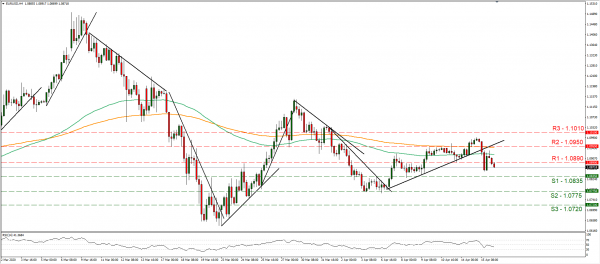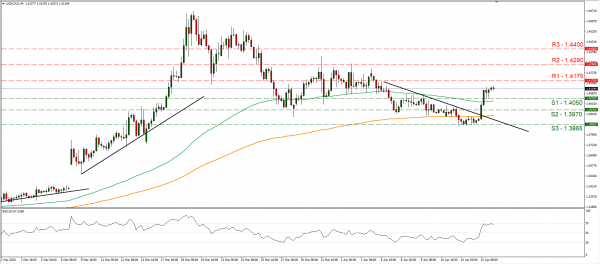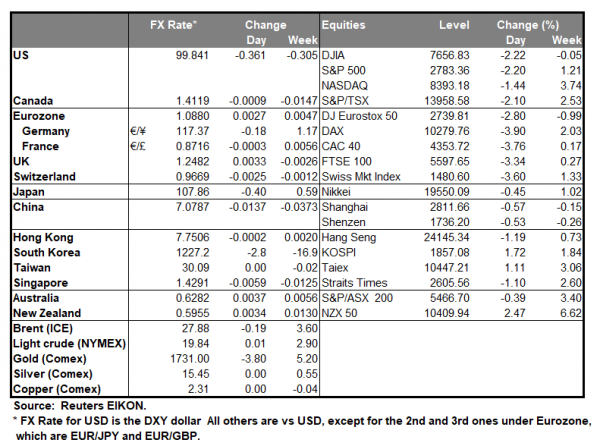The USD strengthened against a number of its counterparts yesterday as grim US financial data flocked investors to its safe haven qualities. Specifically, the NY Fed Manufacturing index hit an all-time low reaching -78.2 for April, while industrial production contracted for March by -5.4% mom and retail sales contracted by -8.7% mom, also a record low. The data released where very worrisome, showing a deep hit for the US economy in March, switching yesterday’s slightly positive market sentiment which had started to emerge. Analysts tend to note that given the scale and breadth of the US shutdown, the economy could contract by 13%, before the restriction measures of social distancing start gradually being reversed. Also, analysts tend to note that they expect some ongoing form of social distancing and lost output to be recovered fully by mid-2022. We could see the market attention being turned towards the release of the US initial jobless claims figure for the week ended 11th of April, for any signs that the US employment market may be bottoming out. EUR /USD tumbled yesterday, breaking the 1.0950 (R2) and the 1.0890 (R1) support lines, now turned to resistance. It should be noted though that despite the pair initially recovering from the heavy losses, later on, the bears regained control bringing the pair once again below the 1.0890 (R1) resistance line in a display of strength. As the pair’s price action also broke the upward trendline incepted since the 7th of April, we switch our bullish outlook for the pair, in favor initially for a sideways movement, however the situation seems to remain fragile. Should the pair come under renewed selling interest of the market, we could see it breaking the 1.0835 (S1) support line and start aiming for the 1.0775 (S2) support level. Should the pair’s long positions be favored by the market, we could see it breaking the 1.0890 (R1) resistance line and aim for the 1.0950 (R2) resistance level.
CAD weakens as BoC expands quantitative easing
BoC decided to remain on hold yesterday maintaining rates unchanged at +0.25% as was widely expected. At the same time the bank expanded its QE program as it announced a Provincial Bond Purchase program of 50 billion, while also announced a Corporate Bond Purchase Program of 10 billion. Both programs are to be put in place in the coming weeks and the bank also stated that it will increase the level of government bond purchases as required. In his statement Governor Poloz stated that commodity-producing countries are being hit twice right now yet repeated that +0.25% remains the lower bound for the bank’s interest rates at the moment. Also, during his press conference, the bank Governor stated that it’s impossible to judge when the economy will be recovering. We could see the CAD slowly recovering from the bank’s interest rate decision, yet oil prices tend to remain at low levels, providing little help. USD/CAD rallied yesterday breaking the 1.3970 (S2) and the 1.4050 (S1) resistance lines, both now turned to support. As the pair also broke the downward trendline incepted since the 6th of April, we switch our bearish outlook in favour of a sideways movement initially. Should the bulls take over once again, we could see the pair breaking the 1.4175 (R1) line and aim for the 1.4290 (R2) resistance level. Should the bears be in charge, we could see the pair breaking the 1.4050 (S1) support line and aim for the 1.3970 (S2) support level.
Other economic highlights today and early tomorrow
Today in the European session, we get Germany’s final HICP rates as well as Eurozone’s industrial production growth rate, both for March. In the American session, trader’s attention is expected to focus on the number of US initial jobless claims for the week ended the 10th of April while we also get from the US the number of housing starts for March and the Philly Fed Business Index for April. Also in the American session, from Canada we get the manufacturing sales growth rate for February April. During tomorrow’s Asian session we get China’s GDP growth rate for Q1, as well as the industrial output growth rate for March.
Support: 1.0835 (S1), 1.0775 (S2), 1.0720 (S3)
Resistance: 1.0890 (R1), 1.0950 (R2), 1.1010 (R3)
Support: 1.4050 (S1), 1.3970 (S2), 1.3865 (S3)
Resistance: 1.4175 (R1), 1.4290 (R2), 1.4400 (R3)
















